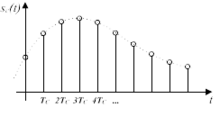sampling rate
The sampling rate or sampling frequency , and sampling rate , sample rate or sampling frequency is, in the signal processing , the frequency at which an analog signal (including continuous-time signal called) in a predetermined time sampled (i.e., measured, and in a time-discrete signal converted ) is. Although the actual sampling only takes place in the context of digitization, this parameter is also called sampling rate for further processing up to and including conversion back into an analog signal.
General
Sampling rate units
Since a sampling is always a periodic process, its basic unit is the hertz (abbreviated: Hz), i.e. periods per second. The continuously changing input signal is only measured at the moment of the sampling process, which means that an instantaneous value is determined each time. Therefore, the individual measurement results are also (English for samples sampling ) called, and we also speak of samples per second, abbreviated SPS, Sat / s or S / s. If necessary, the usual prefixes for units of measurement are used:
- One sampling per second: 1 Hz = 1 S / s
- 44,100 samples per second: 44.1 kHz = 44.1 kS / s (see audio sample )
- One billion scanning processes per second: 1 GHz = 1 GS / s or GSPS (see high-frequency measurement technology ).
Sampling interval
The interval between the sampling times is the sampling interval and is expressed in seconds or parts thereof. If this distance is constant, the sampling frequency f s can be determined from the sampling interval t s :
Following the Nyquist-Shannon sampling theorem , a more than twice as high sampling rate is necessary for a complete mapping of a signal at a temporally constant sampling rate with the highest spectral component f a :
Errors such as the aliasing effect occur when signals with frequencies above f a are sampled . Sampling errors can be reduced by means of an analog low-pass filter to limit the input frequency f a .
The sampling can be carried out by an analog-digital converter which, in addition to the sampling, also performs the quantization and converts the time-discrete signal into a digital signal.
The conversion from a high to a low sampling rate or from a low to a high sampling rate while maintaining the sampled signal is referred to as sampling rate conversion .
Examples
Audio technology
A sampling rate of 44.1 kHz is used for audio CDs . This is sufficient to record audio signals with frequencies up to 22 kHz. With digital audio tape (DAT) a sampling rate of 48 kHz is used in the consumer sector, whereby many devices also have a long play mode with 32 kHz. DAT recorders from the professional sector can also work with 44.1 kHz and were the preferred medium for premasters, the preliminary stage for CD pressing, until around the year 2000.
With DVD-Audio , sampling rates of up to 96 and 192 kHz are possible. Due to the higher sampling rates, the necessary analog low-pass filters for anti-aliasing can work with a lower quality factor , which results in a lower steepness and thus less distortion. The cut-off frequency can also be pushed up so that audio signals with correspondingly higher frequencies are transmitted cleanly.
Video technology
Although the required resolution of the brightness level is lower than with audio, the number of data points to be transmitted is a multiple. In order to display analog television signals with digital video technology , sampling rates in the range of up to a few 100 MHz are used, depending on the bandwidth of the analog signal required.
Digital video data streams are even more complex than digital audio signals. Not only are the audio and video signals transmitted, but additional information such as the blanking and synchronization pulses are also incorporated into the data stream. In contrast to raw data signals for audio and image signals, the data rate of formatted video signals does not make any direct technical statement about the cutoff frequency, as is the case with audio signals. Usual digital video interfaces are, for example, the ITU-R BT 601 and the ITU-R BT 656 , which are operated in SDTV with a sampling frequency of 13.5 MHz.
literature
- Alan v. Oppenheim, Ronald W. Schafer: Discrete-time signal processing . 3. Edition. Oldenbourg, 1999, ISBN 3-486-24145-1 .
- Thomas Görne: Sound engineering . 1st edition. Carl Hanser Verlag, Leipzig 2006, ISBN 3-446-40198-9 .
Web links
- Why 44.1 kHz of all things? - engl. ( Memento from June 13, 2010 in the Internet Archive )



